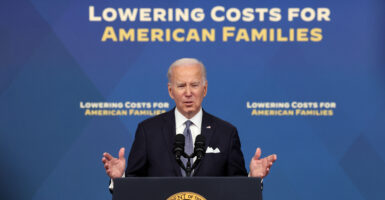For all the White House’s bragging about the strength of the economy, most Americans still don’t approve of President Joe Biden’s performance on this issue. That’s likely because they have been left behind, especially native-born Americans.
This is perhaps most evident in figures from the Labor Department’s Bureau of Labor Statistics. If one looks only at the headline numbers in each monthly report, the economy appears to be off to the races. Nonfarm payrolls are up, and unemployment is down.
But few analysts have bothered asking questions like what kinds of jobs are being added to the economy, how much they pay, who has the jobs, or why the unemployment rate is so low.
The economy is not adding high-paying, full-time jobs that come with benefits. The number of full-time jobs was roughly flat over the last 12 months, so essentially all the job growth was part-time employment. As the layoffs mount, Americans are replacing their previous job with more than one part-time job.
That increases the number of payrolls without increasing the number of people employed, which helps explain the unprecedented disparity between the two categories. The shift to lower-paying, part-time employment has become so dramatic that it is dragging down average hourly wages.
In fact, December and January marked the biggest two-month decline in full-time employment since the government-imposed lockdowns of March and April 2020.
Aside from those losing their primary job, Americans are increasingly taking second or third jobs to make ends meet.
But even the Bureau of Labor Statistics data on multiple jobholders understate the extent of the problem. When a person gets a second job, that increases the number of multiple jobholders. But when that person gets a third job, it doesn’t.
With 60% of Americans living from paycheck to paycheck, it’s no surprise that so many of them have gotten extra jobs as they rack up a record $1.1 trillion in credit card debt to cover necessities.
The low unemployment rate is also a facade as the COVID-19 pandemic recedes from the headlines, the product of over 5 million workers missing from the labor force. The number not in the labor force was trending down before the lockdowns in early 2020, but it has remained elevated since then and is still above June 2020 levels.
Adding those missing workers back into the labor force yields an unemployment rate of over 6%. While not horrific, that percentage is common during recessions and shows that Americans are not faring as well as is being portrayed.
Yet the best explanation for Biden’s poor polling on the economy has to do with who is getting these millions of new jobs. It turns out they aren’t native-born Americans.
Although last month’s job data quickly garnered hyperbolic terms like “blowout,” a fairer word would be “depressing” for many Americans. Native-born employment not only was a whopping 5.5 million below its pre-pandemic trend, but also was 121,000 below its pre-pandemic level, or 0.1%.
Conversely, foreign-born employment was 2.8 million above its pre-pandemic level, or 10.3%, having returned to the pre-pandemic trend last year. It turns out all the job gains since the beginning of 2020 have gone to the foreign-born; on net, native-born Americans have lost jobs.
Even the Bureau of Labor Statistics concedes that its figures reflect at least some illegal aliens working in America. With millions of such illegal aliens pouring across the southern border due to Biden administration policies, it makes sense that this would augment the workforce of foreign-born people here legally and boost employment numbers.
That native-born Americans have made no progress in terms of job numbers in four years is a key reason why they view the economy so poorly, but it isn’t the only one. Their inflation-adjusted weekly earnings are still down 4.2% under Biden, according to the government estimates.
The reality is even worse because the Bureau of Labor Statistics has grossly undercounted many price increases, such as the cost of homeownership. Using rental data, the BLS estimates this has risen by less than 20% in the last three years.
Conversely, the Federal Reserve Bank of Atlanta uses real-world housing data to estimate that the cost of homeownership has risen 76.5% over the same time, or four times the official metric from the Bureau of Labor Statistics.
It is surprisingly easy to square the circle of good economic headlines and lousy polling on the economy: The benefits of Bidenomics go to a few, and Americans as a whole come last.
Originally published by The Washington Times
Have an opinion about this article? To sound off, please email letters@DailySignal.com and we’ll consider publishing your edited remarks in our regular “We Hear You” feature. Remember to include the URL or headline of the article plus your name and town and/or state.

























